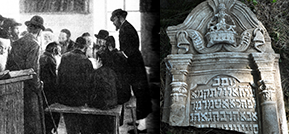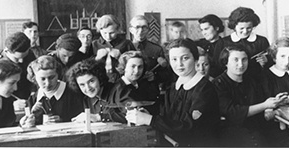Tarnow
Name in English:
Tarnow
Name in Ukrainian:
Та́рнів (Тарнув)
Name in Polish:
Tarnow
Name in German:
Tarnau
Name in Russian:
Tarnov (Тарнув)
Name in Hebrew:
טרנוב
Name in Yiddish:
Tarna [טרנא]
Historical-cultural region:
Western Galicia
Administrative District :
Lesser Poland Voivodeship
Administrative History:
Years |
State |
Province |
District |
Until 1772 |
Polish-Lithuanian Commonwealth: Kingdom of Poland |
Rus Voivodship (Województwo ruskie) |
|
1772-1867 |
"Habsburg Empire", since 1804 - Austrian Empire |
Kingdom of Galicia and Lodomeria (Königreich Galizien und Lodomerien) |
|
1867-1914 |
Austro-Hungarian Monarchy |
Kingdom of Galicia and Lodomeria (Königreich Galizien und Lodomerien) |
|
1914-1915 |
Under Russian occupation |
General-Government Galitsiia |
Tarnow,Galiscia, Austro-Hungarian Monarchy |
1915-1918 |
Austro-Hungarian Monarchy |
Kingdom of Galicia and Lodomeria (Königreich Galizien und Lodomerien) |
|
1918 - May 1919 |
West-Ukrainian People's Republic |
|
|
May 1919 - September 1939 |
Republic of Poland |
Stanislawów wojewódstwo |
Tarnow powiat,Krakow wojewódstwo |
|
|
|||
September 1939 - June 1941 |
USSR: Ukrainian Soviet Socialist Republic |
Stanislav oblast' |
|
June 1941 - July 1944 |
Under German occupation:General Government (Das Generalgouvernement für die besetzten polnischen Gebiete) |
Distrikt Galizien |
|
Since 1945 |
Republic of Poland |
Malopolsky wojewódstwo |
|
Population Data:
| Year | Total | Jews | Percentage of Jews |
| 1765 | ? | 1,080 | - |
| 1820 | ? | 1,640 | |
| 1880 | 24,627 | 11,349 | 46% |
| 1890 | 27,574 | 11,677 | 42.3% |
| 1900 | 31,691 | 12,586 | 39.7% |
| 1910 | 36,731 | 15,108 | 41.1% |
| 1921 | 35,347 | 15,608 | 44.1% |
| 2006 | 117,109 |
Items relevant to the community
| Title | Type of item | Years |
|---|---|---|
| "Statut dla izraelicko-polskiej szkoły ludowej ... | CAHJP Cards | 1890 |
| 1. Okólniki, sprawozdania, korespondencja i inn... | CAHJP Cards | 1882 |
| 1. Okólniki, sprawozdania, korespondencja i inn... | CAHJP Cards | 1898 |
| 1. Okólniki, sprawozdania, korespondencja i inn... | CAHJP Cards | 1898 |
| 1. Sprawozdania o wystąpieniach antysemickich w... | CAHJP Cards | 1881 |
| 1.Korespondencja z MSW w sprawie zmian imion, s... | CAHJP Cards | 1906 |
| Ahavat Zion in Tarnow | Organizations | 1896 |
| Betty Weissbach | People | 1931 |
| Conference of the Ahavat Zion association in Tarnow, 1899 | Documents | 1899 |
| Correspondence with the Landesgubernium , repor... | CAHJP Cards | 1829 |






